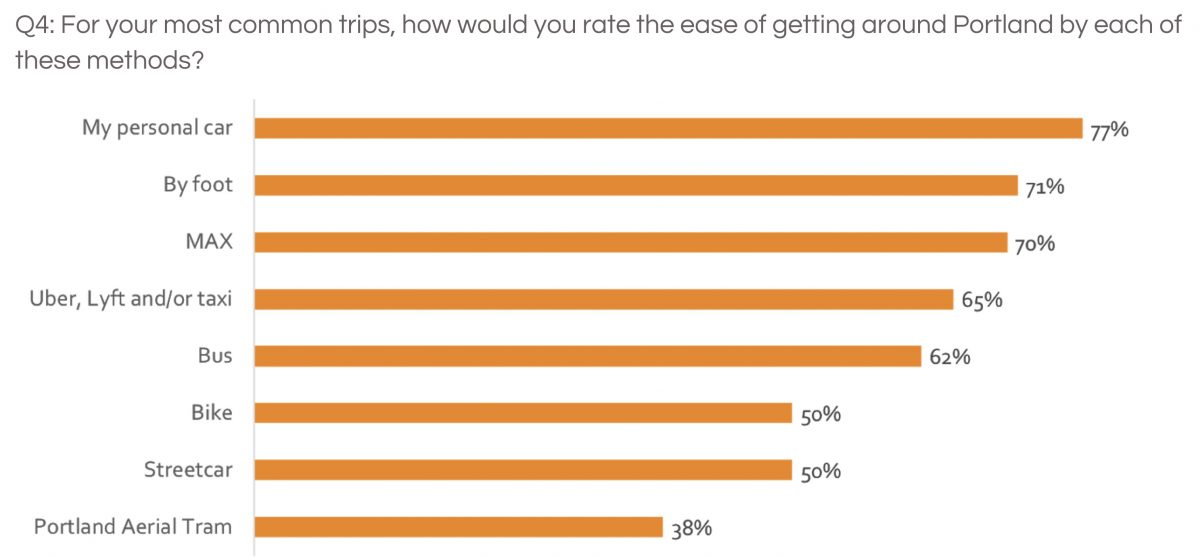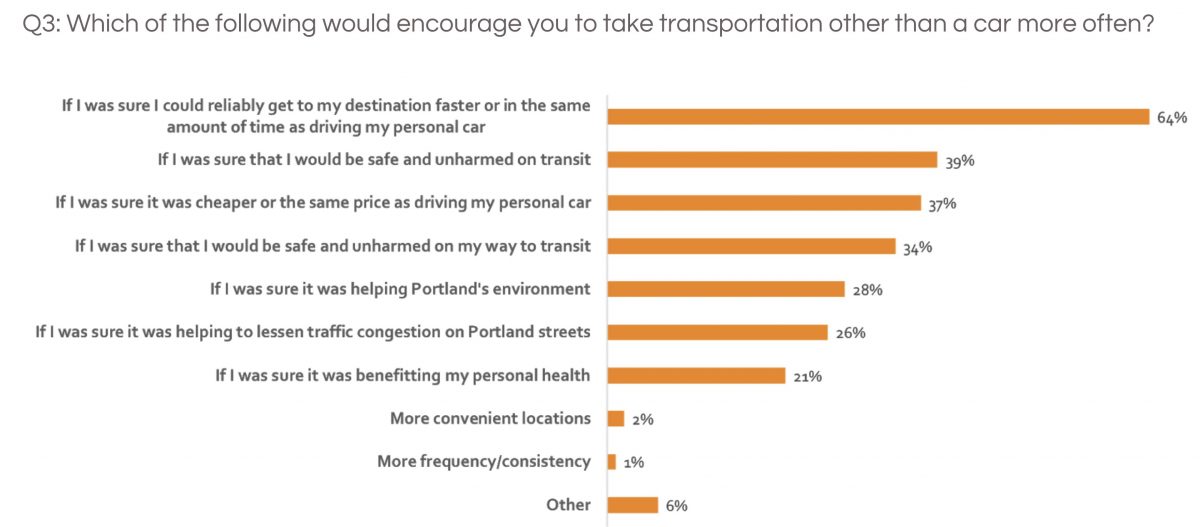A poll commissioned by the Portland Bureau of Transportation found that a large majority of Portlanders don’t think widening roads is the answer to congestion and that the agency needs simpler messaging and a clearer vision.
Those are just a few of the findings from a wide-ranging report (PDF) by Bloom Communications that was completed in fall 2018. The report has been used internally by PBOT since then but was not made public until a records request by a BikePortland contributor was filled last week.
Bloom, a public relations firm with offices in Austin and Portland, conducted a 22 question poll with 1,000 respondents, hosted two focus groups and held a series of interviews with high-profile internal stakeholders. Among those interviewed were: former PBOT Director Leah Treat; Division Manager of Construction, Inspection and Pavement Todd Liles; Traffic Safety Section Manager Dana Dickman; and Oregon Department of Transportation (ODOT) Office of Urban Mobility and Mega Project Delivery Director (and former transportation policy advisor to Governor Kate Brown) Brendan Finn.
The results shared in the 65-page report give PBOT a baseline for how the public feels about the agency and its work. According to PBOT Director of Communications John Brady, the agency had never before gone through a comprehensive polling and perception exercise. The report says PBOT has instead been, “Relying on anecdotal evidence to inform communications strategies.”
In addition to gauging perceptions and behaviors of a scientifically significant number of Portlanders, the report gives PBOT a deeper understanding of how to frame their messages and be more effective as an agency.
Advertisement
Stakeholder interviews reveal an agency with room to improve when it comes to internal and external communications. “We have a little bit of an identity crisis,” one interviewee stated. “One minute Vision Zero is the leading thing; one minute potholes is the leading thing. There are too many things going on at once, and it gets confusing,” stated another. One stakeholder said messaging about projects is inconsistent because it’s the responsibility of each individual project manager. Bloom summarized the issue by writing, “The amount of various transportation projects PBOT is responsible for leads to muddled messages and brand confusion. Many Portlanders are unsure of what PBOT actually does and why they do it. Portlanders are overwhelmed by the volume of the bureau’s projects and messages.”
On-street infrastructure was found to be confusing to people as well. Under the heading, “Operational Actions”, Bloom advised PBOT to improve traffic signage. “PBOT should prioritize making traffic lanes and signage consistent throughout the city. Lack of/inconsistent signage causes confusion for both bikers and drivers and increases safety risks. There should be no question about the division of car/bike lanes.”
On this topic, one focus group participant said, “I fully endorse putting bike lanes in… but it feels like they’re changing their minds continuously on how they want to do that. Some areas there are green stripes, some areas it’s on the edge, some areas it’s in the middle, some areas they’re taking the entire lane out.
Advertisement

Bloom also noted the tension between PBOT and ODOT. “At the state level, the priority is primarily congestion relief in the form of getting more cars through the roads… Because PBOT’s goal is to get more people through Portland with multi-modal transportation, inconsistent messages are being presented to the public. An internal stakeholder said of the PBOT/ODOT relationship, “We don’t always get good information from the state on their priorities vs. our priorities. We could better collaborate to send out the same message.”
Another finding that stood out was how often focus group attendees mentioned a fear of strangers as the reason they choose to drive.
“I can control who’s in my space when I’m in my car, and I don’t have to worry about someone random bashing me in the back of my head while I’m driving… When you don’t know people, they could look completely normal, and next thing you know…” said one person. “I was one of the people that was on the MAX when [the stabbing happened]. Right after that is when I got my car,” said another. Bloom called this a, “Collective fear of other people and the uncertainty that comes with being around those you don’t know,” and determined that, “Portlanders generally feel safer in a car because they have some control over what happens to them and their families.”
“In addition to a fear of the homeless population and overcrowding,” the report continues, “Portlanders are driven to take their cars because of dirty streets and unmodernized public transportation assets.”
Bloom urged PBOT to make addressing homelessness a priority and to partner with nonprofits that serve them. Asked about the issue, PBOT’s John Brady said, “We didn’t act on that recommendation.”
In other recommendations, Bloom tells PBOT they should be more direct in telling people they’ll have to start driving less if they want to decrease congestion. “PBOT should explicitly communicate to Portlanders that building more infrastructure is impossible,” the report states. “While this message must be direct, it also must be understanding of the major lifestyle change solving traffic congestion requires.”
Advertisement
Brady said in a phone call yesterday that Portlanders’ rejection of road widening, “Was a really nice validation.” He said the bureau put that information to use when crafting messages for their Central City in Motion plan.
In order to encourage people to drive their cars less, Bloom advised PBOT (based on polling results) to focus on environmental benefits, affordability, and the convenience of not having to find parking.
The report also urged PBOT to create a new mobile app to garner feedback on all projects and programs, saying the existing PDXReporter tool has a “huge barrier to entry”.
Brady says the report was, “Really valuable” and that, “it has helped us define our audience a lot better.” He noted that people who bike, walk, and take transit have a better perception of the bureau’s work than people who mostly drive. Another thing he took away from it is that PBOT needs to keep thing simple. “We’re making more of an emphasis on that internally, trying to get folks to talk to the layperson, to de-wonkify the language.”
Here are some interesting numbers from the poll:
– 68% don’t think widening roads is the answer to congestion.
– 65% would be willing to pay more in taxes if they knew the money would be going directly to traffic congestion.
– 55% would be willing to pay more to drive during peak times if it meant a quicker commute.
– 90% say more needs to be done to improve the safety of Portland’s roads. Only 76% feel safe walking the streets of Portland.
– 47% do not know about Vision Zero.
– 90% want to see more enforcement of traffic laws.
– 60% get their information from from local TV news versus 40% from online news sites and 38% from social media.
– 51% use a private car every day.
– 17% use a bicycle every day and 43% ride at least once per week.
– 64% said they’d stop using their car if other options were reliably faster or the same amount of travel time.
– 77% said driving a car is an easy way to get around Portland, compared to just 50% for biking.
Download the report here.
— Jonathan Maus: (503) 706-8804, @jonathan_maus on Twitter and jonathan@bikeportland.org
— Get our headlines delivered to your inbox.
— Support this independent community media outlet with a one-time contribution or monthly subscription.



